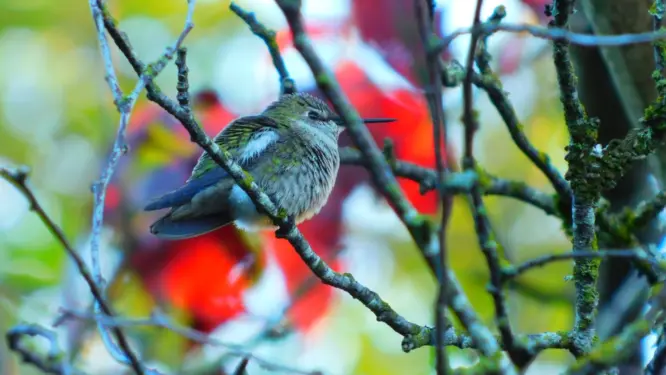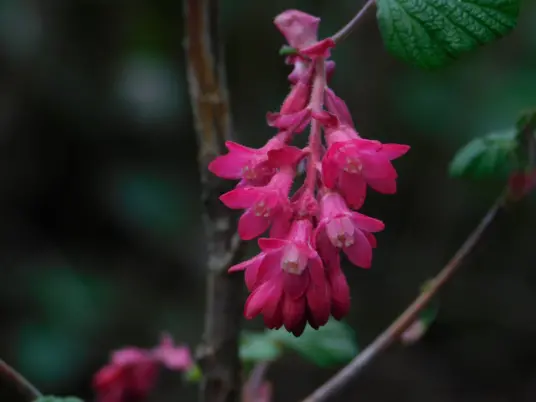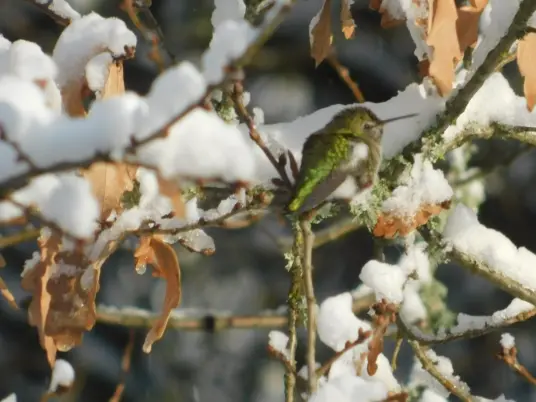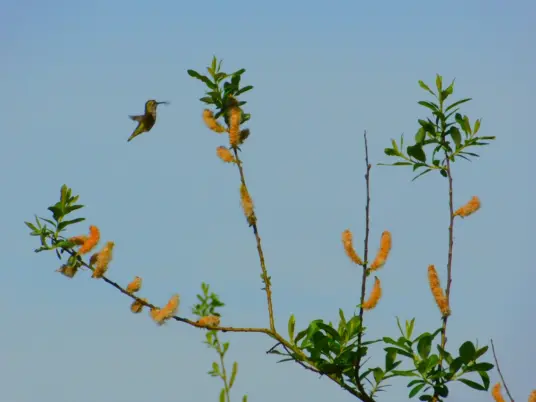Anna Story to Tell: Hummingbirds on Campus

by Marcia Wilson
Spotlight Species: Anna’s Hummingbird, the Calypte anna.
Somewhere in the greenery circling Building 14 on the Lakewood Campus, rests an Anna’s hummingbird nest. The adults are bold, swift, and decisive when they dip between Buildings 11 and 15. The birds have startled many a human into looking up, wondering about an odd buzz in the air followed by rapid and high-pitched pops.
Hummingbirds are a rare gem among birds. They can fly astounding distances very quickly: A Rufous banded in Prince William Sound was found six months later…in Florida!
Anna Going Native?
Anna’s were not originally native to Washington State. They originally hailed from Baja and Southern California. They moved north, following the food humans planted (nectar-rich trees, shrubs and flowers). Feeders helped their migration too. Anna’s are casual with humans, and have learned to not only survive, but thrive in suburban yards. This adaptation is called ecological release and applies to conditions where a species is freed from the limitations of its original environment. Humans often face negative impacts of ecological release, but in the case of the Anna’s Hummingbird, the presence of the bird is benign and harmless to the Pacific Northwest.

The CPTC wetlands and Outdoor Lab hosts Anna’s hummingbirds all year long. but Spring shows a large upswing in numbers flying in from the south. When the Red Flowering Currants bloom, say old-timers, come the hummers.
Winter has less in the way of flowers, so they supplement their diets with feeders, tiny insects, and drinking the sap out of trees drilled by woodpeckers. They also have the trick of dropping their metabolism down by as much as 95% and taking a “hibernation nap” called a torpor. In this state they look dead–especially when they are found hanging upside down.

Anna Who?
The naturalist Rene Primevera Lesson named the little hummingbird after Anna Masséna, Duchess of Rivoli. The woman never saw a living hummingbird but she possessed similar traits. She was described as small, frail, delicate, graceful, and possessed of surprising strength of character and force of will. Strangely, Lesson’s wife Marie Clémence was an ornithologist and an illustrator who worked on his many books. Why did he not name the bird after his own wife? Or for that matter, any of the birds he wrote of? The answer is mostly likely the politics involved and flattering the rich patrons.
Some Fun Facts About the CPTC Hummingbirds:
Anna’s are in a Level 3 Status for the Pierce County Bird List. This means the birds are “harder to find than uncommon birds, and usually seen annually.” The Rufous Hummingird is Level 1, the most common bird for the county. At the CPTC Outdoor Lab the statistics are reversed. One is far more likely to see an Anna’s Hummingbird than a Rufous. This is largely because the Anna’s adapts well in suburbia and ecological release.
Hummingbird nests are made of lichen, spiderwebs, and soft, fluffy plant matter like cattail poofs or pussywillows. When they hunt for nest materials they can be so focused they forget to look for people.

Larger birds like jays and kestrels prey on them, so they often nest close to raptors like larger hawks. Hawks will hunt the crows, jays and squirrels that rob their nests but generally think the hummingbirds are too small to bother hunting for themselves.
Hummingbirds are sight-oriented and they see reds-to-yellows on the spectrum better than humans. Bright colors mean food or trespasser. Students and Faculty on field trips get more up close visits from hummers if they are wearing reds and purples. Some birdwatchers will set out nectar feeders with white or yellow flowers in the winter, believing the birds will go to them faster.
Hummingbirds fly backwards and upside down. More than one student has jumped when they were “buzzed” by a hummer in the Outdoor Lab. Sometimes this was because a male was doing a “look at me” dance to get a female’s attention. This dance involves a 110-foot drop through the sky.
The colorful throat feathers are called a gorget. Anna’s are unusual in that the colors extend over their head, like a winter cap. This partly explains their Latin nomenclature. Calypte anna can be translated as, Anna’s Headdress, or, Anna’s Veil.
The Future Is Coming
The Anna’s name will change in 2024. Just as in the case of the Steller’s Jay, we do not yet know what it will be. It is fair to say the new name will be more about the identity of the hummingbird itself.